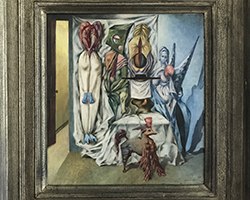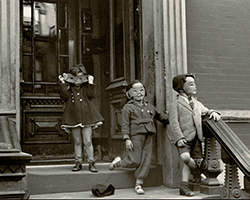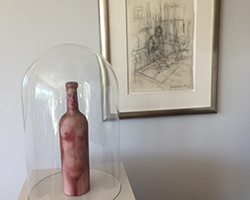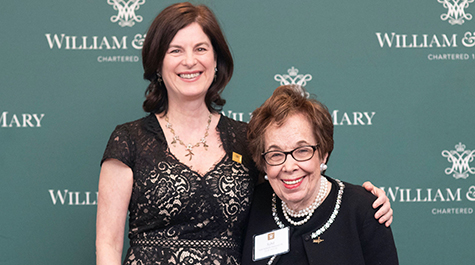Legacy gift features women artists, Picasso, Matisse
Stepping into the New York City home of Sybil Shainwald ’48, LL.D. ’19 next to Central Park is like entering a museum.
“You’re immediately aware of being surrounded by art,” says David Brashear, interim director of Muscarelle Museum of Art at William & Mary. “As you move from room to room, you begin to understand that not only is it an exquisite presentation of art, but there’s also a strong collecting thread that works through it.”
The list of artists represented is jaw-dropping: There are drawings by Henri Matisse and Pablo Picasso; photographs by Richard Avedon, Man Ray and Helen Levitt; sculptures by Louise Nevelson and Henry Moore; charcoal on paper works by Willem de Kooning; a surrealist painting by Dorothea Tanning.
 Those are just a few of the 100 works of art that Shainwald has decided to donate via her estate to William & Mary. Upon viewing the art, a theme quickly emerges — nearly all the pieces portray women, and many were created by female artists.
Those are just a few of the 100 works of art that Shainwald has decided to donate via her estate to William & Mary. Upon viewing the art, a theme quickly emerges — nearly all the pieces portray women, and many were created by female artists.
“At the time I started collecting, I thought that women artists and their work were undervalued and underrepresented,” Shainwald says. That is changing and this transformative gift puts William & Mary in a position to accelerate that positive change.
Advocate for Women
Shainwald’s approach to collecting is consistent with a storied legal career devoted to women’s health cases. Since receiving her law degree in 1976, she has fought for justice on behalf of thousands of women harmed by products such as breast implants, contraceptives and drugs given to pregnant women at risk of miscarriage — both in the United States and in developing countries around the globe. Shainwald’s achievements have drawn accolades from William & Mary, Columbia University’s Graduate School of Arts and Sciences, New York Law School and the New York County Lawyers Association, among others.
“When the history of women’s health in the second half of the 20th century is written, Sybil Shainwald will be right in the middle of that history,” W&M Law School Dean Davison Douglas says in a video tribute for the pioneering social justice advocate, who received an honorary doctor of laws degree from the university in 2019. “She has had an extraordinary impact on women’s health through her work as an attorney.”
Shainwald’s observation about art by women being undervalued and underrepresented remains as compelling today as it was when she started collecting art in the 1950s.
A survey of 18 major U.S. museums published by the Public Library of Science journal PLOS ONE in March 2019 found that 87% of the works in their permanent collections are by male artists. And despite increased attention to the gender imbalance, the numbers don’t appear to be moving swiftly in a more equitable direction. According to data released in September by Artnet News and the In Other Words podcast, works by women represent just 11% of art acquired by museums over the past decade.
 Melissa Parris, director of collections and exhibitions at the Muscarelle, says that art by women comprises about 25% of Shainwald’s collection. Incorporating those into the museum’s holdings not only will increase the number of works by women, but also will spotlight artists who are not currently represented at the Muscarelle, such as Joan Mitchell, Dorothea Tanning, Lynda Benglis and Lisette Model.
Melissa Parris, director of collections and exhibitions at the Muscarelle, says that art by women comprises about 25% of Shainwald’s collection. Incorporating those into the museum’s holdings not only will increase the number of works by women, but also will spotlight artists who are not currently represented at the Muscarelle, such as Joan Mitchell, Dorothea Tanning, Lynda Benglis and Lisette Model.
Planned gifts such as this one are an important part of the university’s For the Bold campaign, comprising one third of the total raised to date. They also demonstrate a strong commitment by alumni and friends to invest in William & Mary’s future.
“Sybil Shainwald’s extraordinary gift will forever change the representation of women artists in the university’s collections,” says W&M President Katherine Rowe. “She shines as a brilliant litigator and a visionary art collector. We are incredibly grateful to her for entrusting William & Mary with this transformative collection.”
With an expansion planned for the Muscarelle’s facility, Brashear envisions eventually displaying Shainwald’s collection in its entirety as an exhibition of art by and about women. He says the museum is also talking with Shainwald about loaning a few pieces in the meantime as a preview and celebration of her gift.
A Forward-Thinking Collection
Among the first works of art Shainwald purchased was an abstract female figure by French-born sculptor Louise Bourgeois. Shainwald’s husband, Sidney, was not thrilled.
“He said, ‘I don’t really like that sculpture,’ ” she recalls. “I said, ‘Well you’ll learn to love it if you look at it long enough.’ ”
Sidney Shainwald, a prominent consumer advocate and certified public accountant who died in 2003, may not have learned to love all of the pieces his wife bought, but his devotion to her held strong throughout their 42-year marriage. During that time, she earned a graduate degree in history from Columbia University, then a law degree from New York Law School — after Columbia declined to admit her into its law program, saying she’d take the place of a man who would practice law for 40 years — then embarked on a decades-long legal career.
 U.S. Supreme Court Justice Ruth Bader Ginsburg, who, like Sybil Shainwald, faced gender discrimination in pursuing a law career and has been a strong advocate for women, noticed a similarity between the Shainwalds’ relationship and her own marriage to Martin Ginsburg. Both women had attended James Madison High School in Brooklyn, although Ginsburg is several years younger, and they met through a shared passion for opera. Two years ago, Ginsburg spoke at the Sidney Shainwald Public Interest Lecture Series, which Sybil founded in her late husband’s honor, at New York Law School.
U.S. Supreme Court Justice Ruth Bader Ginsburg, who, like Sybil Shainwald, faced gender discrimination in pursuing a law career and has been a strong advocate for women, noticed a similarity between the Shainwalds’ relationship and her own marriage to Martin Ginsburg. Both women had attended James Madison High School in Brooklyn, although Ginsburg is several years younger, and they met through a shared passion for opera. Two years ago, Ginsburg spoke at the Sidney Shainwald Public Interest Lecture Series, which Sybil founded in her late husband’s honor, at New York Law School.
“Afterward, she said, ‘Come have a cup of coffee with me,’ so of course I did,” Shainwald says of Ginsburg, “and she said, ‘You and I had the same husbands. They were both supportive.’”
While working as a CPA, Sidney Shainwald represented artists including Jacques Lipchitz, George Grosz and Marc Chagall, and he and Sybil visited their studios.
“I started to buy what I could afford, which wasn’t too much,” Sybil Shainwald says. “I never thought of art as an investment. I bought what I liked.”
Her favorite piece of art is an oil painting of a woman on a wine bottle by Belgian surrealist Rene Magritte. She had tried to buy a similar piece by the artist at a Christie’s auction, but someone else outbid her.
“I was very unhappy,” she says. “Afterward, I went to Christie’s and said, ‘Do you think that when somebody goes over to Belgium, they could get another bottle?’ They called a couple of months later and they said, ‘We have a bottle for you.’ They had seven, all different. I went and picked out the one I liked.”
Renewed Relationship
Based on her time as a student at William & Mary, the university might seem an unlikely destination for Shainwald’s art collection. When she entered as a 16-year-old freshman in the spring of 1945, she wasn’t sure whether she’d remain.
“I called my mother right away and said, ‘I absolutely hate this school. I have to come back to New York,’” she recalls in an oral history recorded in 2017 with Carmen Bolt of W&M Libraries.
Shainwald (then Sybil Schwartz) was one of the few Jewish students at the time, and she was particularly uncomfortable with the racial segregation in the South. While at W&M, she worked on The Flat Hat and took part in a protest when the Board of Visitors demanded the editor-in-chief of the student newspaper, Marilyn Kaemmerle, be fired and school officials temporarily shut down publication of the student newspaper after it published a 1945 editorial calling for African Americans to be recognized as equals and saying that one day black students should attend and fully participate in college life. Six years later, the first black student at W&M enrolled in a graduate program in 1951.
Despite her qualms about the school’s social environment back then, Shainwald speaks highly of her professors. An American history major, she was a President Bryan Scholar and graduated Phi Beta Kappa.
“I did receive a great education,” she says.
Over the past decade, Shainwald reconnected with her alma mater. Gerald Bullock M. Ed. ’97, now the executive director of development for arts and sciences, met with her in 2010 when he was working as an advancement officer in the Northeast region. Two years later, she returned to campus for the first time since graduating in 1948 to attend Charter Day events in 2012. During that visit, Bullock introduced her to Douglas and law professor emerita Jayne Barnard.
She has since returned multiple times to speak at the school, and she established the Shainwald Immigration Law Clinic Fund.
“She became very devoted to our law students,” says Douglas, who is stepping down as dean at the end of June to return to the faculty. “When the students heard her biography, they were amazed. They would just huddle around her. It was clear that the students were mesmerized by her.”
Barnard says that Shainwald often shared meals with students working on the W&M Journal of Race, Gender and Social Justice, and has maintained relationships with many of them as they’ve moved on into their careers.
“Even though she did not attend William & Mary Law School, she’s made it and the Journal part of her life,” Barnard says. “We’ve been so lucky she ‘adopted’ us.”
In addition to receiving her honorary degree during William & Mary’s 2019 Commencement, Shainwald was inducted in 2012 into W&M’s Eta Circle of Omicron Delta Kappa, a leadership honor society for which she was ineligible in the 1940s because membership was reserved for men. Her latest visit to campus was in February for Charter Day Weekend and induction into the James Blair Society, which recognizes donors who have made cumulative gifts of $1 million or more to the university.
Now, Shainwald has another connection to strengthen her bond with William & Mary: Her granddaughter, Emma Shainwald ’20, graduated in May with a degree in Asian Pacific Islander American Studies, with honors. Like her grandmother, Emma has worked to promote inclusivity at William & Mary. During a May 1 online ceremony, she received the Center for Student Diversity’s Ernestine Jackson Award for Cross Cultural Understanding. The award recognizes her efforts to build positive relationships between all members of the W&M community.
When asked what advice she would offer young women, Sybil Shainwald responds: “Go to law school.”
“What I’m interested in is making people’s lives better,” she says. “I like history a lot, but I thought I could make a difference by being a lawyer.”
Through the Shainwald Collection at the Muscarelle, she’ll have yet another way to make a difference for generations to come.
“The art can be used to support study programs in a variety of departments, stretching beyond art and art history to talk about gender, psychology and other academic fields of inquiry,” Brashear says. “That’s how a university museum can have an even greater impact, because it sits so perfectly in the intersection between the art world and the academic world.”
 Skip to main content
Skip to main content

